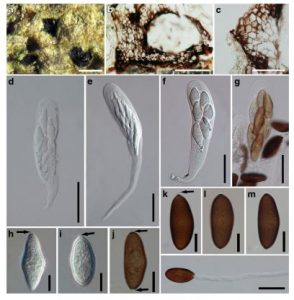Sphaeropsis eucalypticola A.J.L. Phillips, Persoonia, Mol. Phy.;. Evol. Fungi 76:158 (2013), Index Fungorum number: IF805464
= Phaeobotryosphaeria eucalypti Doilom et al., Fungal Diversity 57(1): 190 (2012)
Saprobic on dead branch of T. grandis. Sexual morph: Ascostromata (105−)200–280(−390) μm high (95 −)150 × 250(−300) μm diam. (x = 240 × 200 μm n = 15), black, convex on host tissue, aggregated, initially immersed, becoming erumpent, appearing through cracks in bark, solitary or gregarious, when cut horizontally locules visible as white contents and dark ascospore dots, uniloculate or multiloculate, globose to sub-globose. Peridium composed of several layers of dark brown-walled cells of textura angularis, broader at the base. Hamathecium comprising (5–)10(−15) μm long × 3–4 μm wide, hyphae-like, numerous, septate, pseudoparaphyses, constricted at the septa. Asci (80−)100 − 150(−225) × 20–30μm (x = 138 × 26μm n = 20), 8-spored, bitunicate, fissitunicate, cylindro-clavate or clavate, with a short or long pedicel, apically rounded with an ocular chamber. Ascospores (27−)29–31(−34) × 11–16μm (x = 30 × 13μm n = 20), overlapping biseriate, hyaline when young, becoming pale brown or reddish-brown when mature, aseptate, ellipsoid to ovoid, ends rounded, with an apiculus at both ends, thickwalled, smooth, broader in the center. Asexual morph: Undetermined
Culture characteristics: Ascospores germinating on PDA after 10 h. Germ tubes produced from germ pore of ascospores. Colonies on MEA reaching 20 mm diam. after 2 days in the dark at 25 °C, flat or effuse, undulate, initially white, after 3 days becoming brownish grey (6E1) in the center, white at the edge, reaching the edge of the Petri-dish after 6 days.
Habitat: Known to inhabit dead twigs on Eucalyptus sp. (Liu et al. 2012; Phillips et al. 2013) and dead branch of T. grandis (current study).
Known distribution: Thailand (Liu et al. 2012 and current study).
Material examined: THAILAND, Chiang Mai Province, Muang District, on dead branch of T. grandis, 12 December 2012, M. Doilom, MFLU 14–0273, living culture MFLUCC 13–0701, MKT 132, MUCL 55412, GenBank Accession No:ITS: KM396907, TEF1: KM409644, TUB: KM510365.
Notes: This collection is considered to be S. eucalypticola based on the morphology being similar to S. eucalypticola (holotype) (Liu et al. 2012), as well as from the phylogeneticanalyses in Doilom et al. (2015). Sphaeropsis eucalypticola is illustrated here on T. grandis as it was collected from a different host to that of the holotype (MFLUCC 11–0579), which was from Eucalyptus, and this is also a first report for T.grandis. The asexual morph of S. eucalypticola (MFLUCC 13–0701) was not observed, although they produced fruiting like structures on MEA and PDA.
FIG Sphaeropsis eucalypticola (MFLU 14–0273). a Appearance of ascostromata on host surface. b Vertical section of ascostroma. c Peridium. d–g Asci containing ascospores. h, i Immature ascospores with apiculus at each end (arrows). j–m Mature ascospores with an apiculus at each end (arrows). n Germinated mature ascospore. Scale bars: a = 300 μm, b = 100 μm, c–f = 50 μm, g, n = 30 μm, h–m = 10 μ

